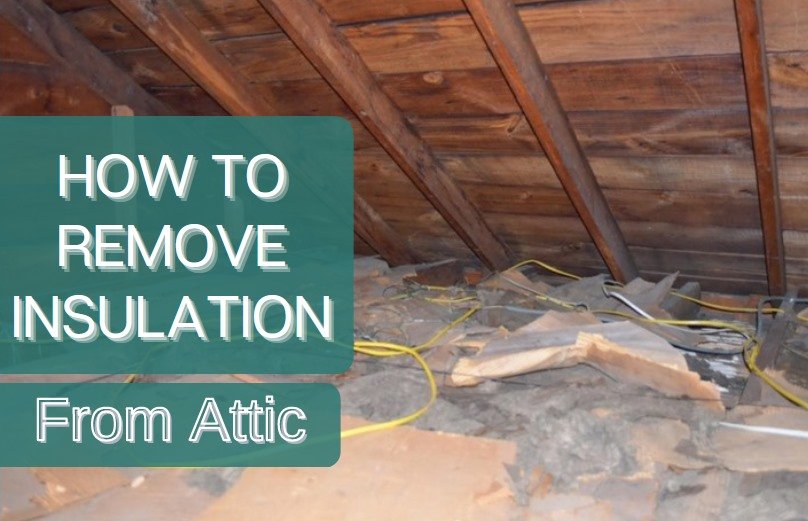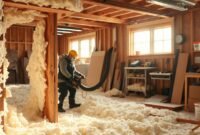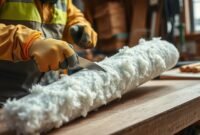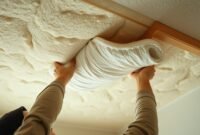It might take a long time and be untidy, and how to remove insulation from attic. It’s good that you found this piece because it contains advice on handling this quickly and effectively. Homeowners should be worried about the condition of their insulation for various reasons.
Old attic insulation removal is a chore that many homeowners eventually have to do. The materials that we use to insulate your home may start to lose their efficacy over time.
Many things may go wrong in this exposed part of your home, from common wear and tear to more significant problems like vermin and pollution, so you might want to consider removing the insulation from the attic.

If you’re considering manually removing insulation, you may do it yourself or hire a qualified expert.
The Way To Remove Insulation From Attic
Preparation – Preparing the attic space is crucial before beginning the removal process, especially when dealing with fiberglass batt insulation. Ensure that the attic access is clear and the area is free of furniture and boxes. This preparation is vital for maintaining an energy-efficient and safe work environment.
This preparation is especially important when dealing with materials like cellulose insulation, which can be more challenging to remove.
Ensure that your attic is free of furniture and boxes. As a result, more room will be made, and goods won’t suffer needless harm or contamination.
Rolling – Typically, removing insulation from attic is rolled up piece by piece and disposed of in safety bags. You should avoid touching your skin when your insulation is full of pollution. A mask may also lessen the possibility of breathing in harmful air.
Vacuuming – For thorough cleaning, use a high-powered vacuum with a HEPA filter to remove any remaining particles. A heavy-duty, commercial-grade insulation removal vacuum, equipped with a long vacuum hose, can reach up to 150 feet, ensuring even the most challenging areas are addressed and that even the farthest corners of the attic are cleaned.
Professionals will bring in an industrial hose (like those used for blown-in insulation) to ensure the area is entirely free when the task is done. If they don’t have the right tools, folks removing their insulation themselves could find this process challenging.
If you don’t have access to such equipment, a standard shop vac can be used, though it may be less efficient for larger attic spaces.
How To Remove Blown-In Insulation From Attic
- Inspect the Insulation
Since there are several types of insulation, you must first determine which one is in your attic.
Although it can also contain other materials, blown-in insulation frequently contains tiny fiber or foam particles. These tiny particles may be sprayed and fit into any aperture to make a tight seal since they are so small.
Read also: Blown-In Insulation VS Spray Foam
Blow-in insulation is popular, but installing insulation using conventional techniques is challenging.
- Gather the Right Equipment
Before you remove insulation from the attic, gather your tools and prepare.
You must wear safety gear like gloves, goggles, long sleeves, trousers, and respirators. You don’t want deteriorated insulation to enter your lungs.
Read also: How to Remove Old Insulation from Attic
You’ll need a lot of rubbish bags to get rid of old insulation. A tarp is also required to remove insulation from the attic, which you may put down behind the bags as you fill them.
Lastly, position your ladder and prepare your wet/dry or HEPA vacuum.
- Protect Your Space
Make sure that any entryways to your home or business are closed. You don’t want airborne pollutants to land in places where you or other people may inhale them.
- Create Your Workspace
The floor is not always secure because blown-in insulation is typically present in older buildings.
Cross wooden planks across the floor joists to strengthen the floor if necessary. You will have a secure and stable surface to walk on.
- Set Up Tarp and Trashbags
You should first set up your disposal place to avoid stumbling while your arms are laden with used insulation. All old insulation away promptly and adequately to lower the number of toxins in the air.
Wherever you want your garage bags to end, lay your tarp on the ground outside. You should keep the bags attached to the tarp as you fill them.
- Put on Safety Gear
The safety gear you collected at your endeavor must now be put to work.
You should always wear safety equipment to avoid irritating your eyes, ears, and lungs.
If fiberglass comes in contact with your skin, it could hurt and burn. You’ll feel compelled to rub it. Don’t. Pushing the particles further into your skin will exacerbate the situation. The irritation will ultimately go away if you wash your skin with water.
- Vacuum Insulation
You may now start to vacuum up the insulation. You should go fast, begin at the attic’s rear, and work your way forward.
If you’re using your vacuum, ensure you empty it frequently by watching it. That respirator will be put to the test.
- Clean Up
Depending on your area’s size, there may be hundreds of garbage bags to pick up.
How are you expected to use it, then?
How To Remove Old Insulation From Attic
When removing old insulation, especially bulky materials like cellulose insulation, squeeze the waste bags to release extra air before sealing them. This method makes disposal more manageable and efficient. You may put each bag inside a second one to make a better seal for peace of mind.
You’ll then need to research how to remove insulation from the attic.
Procedures for disposal and recycling differ by location. Ask the trash management agency in your area what to do with insulation by calling them. The bags may be away with your ordinary trash. In others, you’ll need to transport it to a certain location at the landfill.
You may also call a nearby producer of fiberglass insulation to find out if they offer a recycling program.
Effective Techniques for Insulation Removal
Removing old insulation, particularly in water damage or deterioration cases, is essential for maintaining an energy-efficient and healthy attic space. When dealing with fiberglass batt insulation, handling the material carefully is important to prevent any fibers from becoming airborne.
In addition to using a high-powered vacuum, you may also need to use specialized tools and techniques to remove all insulation from the wall cavities and other hard-to-reach areas.
Bottom Line
You have many options for improvements and repairs on removing insulation from the attic. Many non-insulation contractors prefer and sometimes outright decline to work in an attic before removing all the attic insulation.
Removing insulation from an attic, whether fiberglass batts or another type, requires careful planning and the right equipment. Ensuring your attic is properly insulated and free from water damage or other issues is key to maintaining an energy-efficient home.
If the task seems overwhelming, consider hiring a professional with heavy-duty equipment to ensure safe and effective insulation removal.
Sometimes, it’s just a matter of personal choice on the contractor’s part, and other times the insulation inhibits them from working effectively or safely.
Read also: Is Cellulose Insulation Safe?
You can now easily reach the attic floor, the eaves, the electrical wiring and fixtures, plumbing, and HVAC equipment because the attic is clean and without insulation.
If the task seems overwhelming, consider hiring a professional. They have the expertise and equipment, like commercial-grade insulation removal vacuums, to handle large-scale or complex jobs, ensuring safe and effective insulation removal from your attic.


